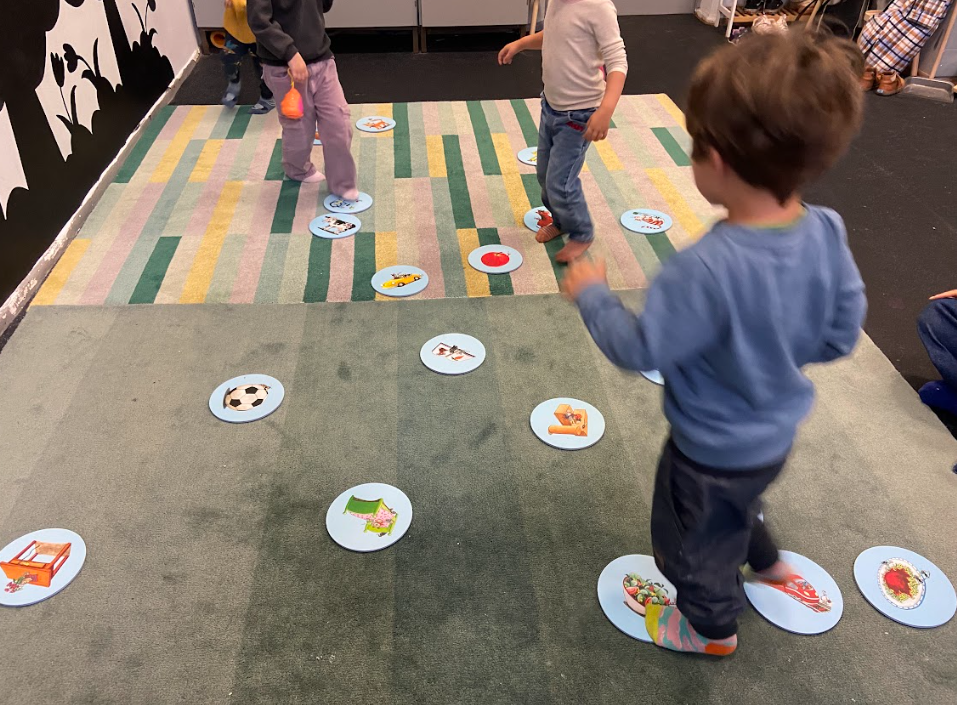Activities Module – Storytelling for Little Ones
This module presents a series of activities for a long workshop to encourage preschool children to use language they know, to learn new words and to engage in various fun and creative activities with/without parents.
Activities Module – Storytelling for Little Ones
This module presents a series of activities for a long workshop to encourage preschool children to use language they know, to learn new words and to engage in various fun and creative activities with/without parents.
150 min (with breaks)
2-6 years old (adaptable for children up to age 12, see below)
Language Skills
Basic to advanced knowledge
Up to 20 participants (depending on age group and also parents’ involvement)
The children were engaged and encouraged to express themselves and use new and known words to describe their ideas. Educators found the activities easy to follow and effective in helping children play and learn together. Parents found the methods easy to understand and follow, they enjoyed learning these simple activities and want to try them at home.
Kinetic sand, a bag of cardboard figures, assorted 20cm diameter picture cards with different images (animals, objects, food, etc.), music player, story cubes, thick sheets of paper, liquid paints (different colours), pipettes, straws, markers, googly eyes, stickers, emotion/feedback cards.
These tools can be used in other languages with pictures instead of words.

Languages Available
Content of Module Activities
- Introduction/Ice-Breaking
- Sand Storytelling
- Stop Dance With Pictures
- What Happened Next? Group Storytelling With Story Cubes
- My Fantastic Story
- Closing Session / Gathering Feedback Of The Participant

For Educators & Teachers
Preparation
Find out about the language and skill levels of the participants and decide whether you need parental support. Prepare materials and tasks appropriate to the language and skill level of the participants. You need specific resources and tools to implement the activities, such as games, visual aids, and storytelling materials. These tools can be used in other languages with pictures instead of words.
Expected output
The children were encouraged to speak and inspired to communicate in their heritage language. Parents expressed interest in the games and methods and noted their effectiveness.
Adaptation/Application of the method
a group with varied language proficiency
This method requires a basic knowledge of the language. The methods and games can be used with different language levels.
Add more words and make the sentences longer and more complex to make the tasks more challenging. The activities can be done with different language levels.
The methods and games can be adapted to the language skills of the participants. For beginners, the tasks can focus on basic vocabulary and simpler sentence structures. For more advanced participants, they can be made more challenging. The visual materials and illustration-based activities also ensure that those with minimal language skills can participate.
other languages
All these activities are easily adaptable and can be translated into other languages as they use visual material without the use of written words. All illustrations are easily adaptable to any language.
bilingual/multilingual options
The activities can be done in different languages. The methods use lots of pictures, so they can be easily translated into different languages. Learners can work in their mother tongue while gradually learning the target language. The activities can also be adapted to help learners from different language backgrounds communicate and work together.
cultural context
Images and stories for activities can be culturally relevant.
other age groups
The activities can be adapted for other age groups. For younger children, the tasks can focus on simpler vocabulary, shorter sentences and more interactive, game-based learning with visual aids and storytelling. For older participants or adults, activities can include more complex language structures, advanced vocabulary and critical thinking exercises. The flexibility of the methods allows adjustments to be made to the level of difficulty, pace and content, making the activities engaging and suitable for a wide range of age groups
distance learning options
The activities can be done online.
You can use video conferencing tools like Zoom or Microsoft Teams to interact with other participants in real time. Breakout rooms are for smaller groups.
You can share visual aids and games online. Slideshows or interactive PDFs ensure all participants have the same materials, regardless of location.
Google Docs, Padlet and Miro help learners work together in real time.
Recorded sessions. Workshops can be recorded and watched later.
\Asynchronous learning activities can be adapted by providing clear instructions, video demonstrations and engaging online resources. This allows learners to complete tasks independently at their own convenience.
challenges
– People have different language skills. Some participants may have better language skills than others, which can make it hard to include everyone. Facilitators should be ready to change activities to suit different language abilities and make sure everyone is included.
– Group dynamics: Group dynamics can be hard to manage, especially if people are shy. Facilitators should encourage engagement and create a supportive atmosphere.
– Limited resources or materials: Some workshops may need special materials or tools that are not available on-site. Facilitators should have backups in case of shortages.
– Time management: Workshops may take longer than planned if participants need extra time. Facilitators should be flexible and ready to adjust the schedule as needed.
– Cultural sensitivity: Participants may come from different cultures, so they may have different views on activities or topics. Facilitators should be aware of differences and prepared to deal with any misunderstandings.
– Space limitations: The workshop space may not be suitable for the planned activities. Facilitators should assess the space and adapt activities if needed.
– Long sessions may lead to participant fatigue, reducing engagement and focus. Facilitators should plan for breaks and incorporate varied activities to maintain energy levels.
– Gathering feedback in a live setting can be challenging, especially if there is a large group. Facilitators should consider using quick, anonymous feedback methods to gauge participant responses.
options for parents
Parents can repeat the activities with their children, especially once they know the rules. The materials and formats are easy to understand, so children can do the activities on their own or with others. The instructions and tasks can be adjusted, so children can practise at their own level. In a group, one child can take on the role of a guide, so the activities can continue without direct supervision. This format encourages children to learn and work on their own.
Developed by / Origin / Original language
Marinessa Radchenko, Koopkultur e.V. / Ukraine, Germany / Ukrainian, Russian
References, and Resources
Story Cubes and Cards to purchase:
https://flyingtiger.com/de-de/products/guess-what-pantomime-and-sound-game-3035609?variant=42532237639878¤cy=EUR&gad_source=1&gbraid=0AAAAAC0qIiqpoxanvDNzLehRpdTxef2VX&gclid=EAIaIQobChMI3rb16tv3iAMVnDwGAB0TywjtEAQYASABEgKzgfD_BwE
https://flyingtiger.com/products/storytelling-dice-3017920?srsltid=AfmBOooew2ll6OH1h0yj9SCiduhHVsSukKgcv8MQRZ_UPaYIgCaZqxi4
https://amzn.eu/d/dQIeftL
Instagram Marinessa Radchenko with more activities and books for children in Ukrainian: https://www.instagram.com/marinessa_rad
Similar Activities
The Intruder – Card Game (DUPLICATE)
The Intruder - Card Game The Intruder - Card Game A Fun and Engaging Multilingual Card...
Art and Fashion – The Wawel Heads
Art and Fashion – The Wawel Heads Museum visits are an excellent way to combine heritage...









